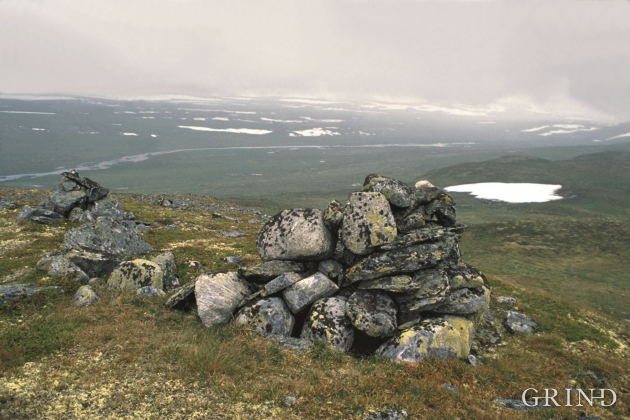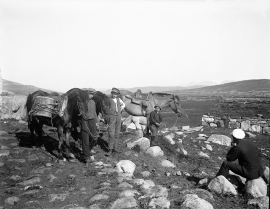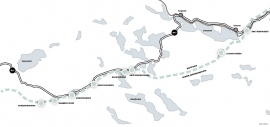Published: 19.05.2009 | Author: Per M. Bremnes
The cairn at Nybunut (Helge Sunde).
It is an August morning in 1615. Most of the inhabitants of Eidfjord have assembled down by the fjord, in Vik. They are waiting for the bishop. A small group standing a bit further out at Stavanes are the first to catch a glimpse of the boat, bearing down with full sails west of Erdal. A horseman rides at full speed to the church at Lægreid to tell the pastor who is making the final preparations for the visitation: The bishop’s boat, with bishop Scavenius on board, is on its way in the Hareid sea!
This is how we might imagine a contemporary visit by the bishop to Hallingdal and Valdres; the easternmost part of Stavanger diocese. When he approached Eidfjord, he had a long journey behind him over sea from Stavanger to Sandeid, over land to Ølen, and then by boat the entire length of the Hardanger fjord to Eidfjord. Ahead was a strenuous trip across the Hardanger mountain plateau. From Eidfjord it was the shortest route across the mountains to Hallingdal, and at the coaching inn in Vik, the Bishop was provided with the men that were to guide him on the first section of the long and dangerous journey across the plateau, as far as Halne.
The bishop could only request transport within his own diocese. This was the reason that Eidfjord belonged to Stavanger diocese from 1126 to 1631; “for the sake of transport”, as it is stated in a report from a royal commission in 1636. Eidfjord belonged during this period to the Hallingdal rectory, which for historical reasons was under the Stavanger diocese.
The day after Bishop Scavenius arrived in Eidfjord, preparations were complete for the trip over the mountains. Two theology students that the bishop had a particular interest in accompanied him during the trip. Students were often scribes during these trips, and the bishop also travelled alongside other travellers, when rank and position permitted.
When the bishop had signed the church register, he was ready to start his voyage to Hallingdal. This journey marked the end of a long tradition dating back to mediaeval times. Scavenius was the last Stavanger bishop to take the so-called “bishop’s route” across the Hardanger plateau. The route partly followed the great Nordmannsslepet and partly the northern one.
The great nordmannslepa
Slepa, the ancient “drove roads” across the plateau, date back to prehistoric times. Through the centuries cattle have been driven to the markets in the east; the people of Hardanger went on their trading journeys with tallow and salt to the mining town and silver mines of Kongsberg, and soldiers and other travellers also used these roads. When they reached the plateau, it was easy for the bishop’s party to find the road ahead.
The first part of the journey, through Hjølmodalen, passed without incident. This was also the ordinary local road to Sysendalen in those days. In the neighbouring valley, the deserted and remote Måbødalen, it was difficult to make headway. In the mid-1600s there were a couple of paths – Kyrkjeskori and Tymberløypet – that led up to the mountains, but they were suitable only for those with experience of the mountains. It was not until the end of the 1700s that bridges were constructed in Måbødalen. This was also when the path up Måbøberget was built, with its numerous rock steps.
To the bishop this was a rather unusual and strenuous trip. Not so for his guides, who easily climbed up Hjølmoberget. The route they followed passed Tjukkaskog, through Berastølsdalen, Hadlet, Fruo and down to Drolstølen. The steps down to Drolstølen bore witness that this was well travelled route. Slepa – the actual name in this context means “trail” – had been in use since time immemorial, and this was the main route over the mountain between Eidfjord and eastern Norway. More than 200 years later the route was named “the great Nordmannsslepa”. There was a lot of activity here during the times of herding. Countless hooves trampled the steps the lie there today as a reminder of bygone times. From here paths departed along Drolstølsgili to Vakavadet and Krossdalen; two locations central to herding during the 1700s and 1800s. However, the bishop’s party was not headed that way, they went up the valley in the direction of the pronounced peak that lay there.
To the right lay the great Allgården. Above it a road passed that led down the gorge between Allgården and Fagernut. But that road was mostly used during early spring, when the snowdrift down towards Drolstølsgili was large. The terrain towards Hallingsskeid was easy to traverse. Just beyond Hallingsskeidet lay the cairn that marked the intersection between the road to Hallingdal and the road to Numedal. The bishop and his party, who were destined for Hallingdal, took off towards Særebakken. It was here that one of the other Nordmannsslepa originated: the northern Nordmannsslepa.
Mountain cairns
The guides were probably not always overjoyed by their guiding duty. Their greatest fear was mountain fog. The terrain was open and it was easy to make mistakes. A lot of people had experienced just that. The cairn just north of Nybunut bore witness to it. When there was fog, the cairn, which was more than two metres tall, attained massive proportions. There were several such large cairns across the mountain, essential to journeymen. The cairn at Nybunut was not just important for those who followed the route taken by the bishop’s party, it was also a landmark for those who in the 1700s and 1800s travelled the herding route between Krossdalen and Numedalen. On a map from 1776 by roadmaster general Hammer, a cairn is marked as “Warde”. There is much evidence that the cairn at Nybunut is identical to “HAMMER’S VARDE” (Hammer’s cairn).
The trail followed the valley upwards, passed west of the cairn and north of the small Skiftesjøen lake. The bishop registered everything. He was collecting information for a map of the diocese; information that would be used by several cartographers of the 1600s. These 17th century maps are surprisingly detailed with respect to the bishop’s route. On one of the maps, the names of three rivers are recognisable: “Biore Elf”, “Krecken Elf” and “Gron Elf”; the Bjoreia, Krekkja and Grøna rivers.
On the height where they looked out across Skriftessjøen lake, the bishop’s party had reached the parish boundary between Hardanger and Hallingdal. The Eidsfjord farmers’ guide duty was over. From the height they could see the cairn at Nybunut, and where they stood were two cairns. One of them was of the same size as “Hammer’s cairn”. Because this was where the bishops changed their guides, this cairn had been named “The Bishop’s cairn” or “Biscopsvaare” as is inscribed on the 17th century maps.
Along the southern shore of the great Skiftessjøen lake came the guides from Hallingdal.
The origin of the name Skiftessjøen has several different explanations. A likely theory is that the name is derived from the word “Skotskipti”. This is mentioned in “Norway’s old laws up to 1387”, and is explained as the place where horses were changed. It is meaningful to interpret the name as “the lake where the change (of horses) takes place”. The border between easterners and northerners was probably here during ancient times.
We can imagine that it was well into the day when the party left the Bishop’s cairn, with a fresh crew bound for Halne; the refuge that was subsequently to become famous. These were originally hunters’ cabins. When Bishop Scavenius travelled here, the cabins were newly built, and they were probably larger than the ruins we see today. Whether this refuge is identical to the so-called “Biscopsbod”, found in literature in the 17th and 18th centuries, is uncertain.
The district recorder Palludan wrote in 1743 that “…the hut that Jone Ramie (Jonas Ramus 1715) reported as being on the middle of the mountain does not exist, but there is still a rock cairn, which is called Bishop’s cairn, and in the parish of Aal the legend goes that when the Bishop travelled from Stavanger to Aal he rested at that very cairn.”
In this way a bishop’s journey in 1615 can shed light on the old roads across the Hardanger plateau – roads that are becoming lost in a distant past.
The Drove Roads, the old trails across the mountain plateaux were used for mountain pastures or packhorse transport or for trading journeys between east and west. Along the drove roads we find many pens and droving stockades where the cattle were fattened up before they were driven over to the markets. (Anders P. Wallevik, owner: Hardanger Folkmuseum).
- Bremnes, P. M. (1988) Bispeveien over Hardangervidda. I: Årbok for Valdres. Valdres, Valdres historielag, s. 138-141.
- Bremnes, P. M. (1993) Gamle ferdslevegar frå Eidfjord over Hardangervidda. Eidfjord, Eidfjord kommune.
- Fønnebø, R. (1988) Langs Nordmannsslepene over Hardangervidda. Oslo, Universitetsforlaget.
- Kolltveit, O. (1969) Stavangerbispane og Bispevegen over Hardangervidda. I: Hardanger. [Utne], Hardanger historielag, s. 258-265.
- Olafsen, O. (1911) Veie i Hardanger i gamle dage. I: Hardanger. [Utne], Hardanger historielag, s. 16-27.
- Olafsen, O. (1920) Samfærdsel og veie paa Hardangervidden i ældre tid. I: Den Norske turistforenings aarbok. Oslo, Den Norske turistforening, s. 4-10.






